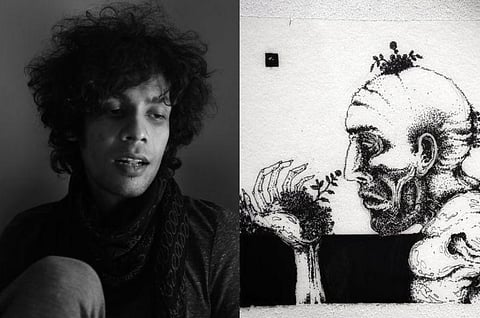
- HOMEGROWN WORLD
- #HGCREATORS
- #HGEXPLORE
- #HGVOICES
- #HGSHOP
- CAREERS
- ABOUT US
- CONTACT US

Meet Aranya Gupta, a homegrown visual artist, hailing from the dense forests of Shalboni, Jhargram in West Bengal. In a candid interview with them, we delved into the artist’s personal life and artistic process.
Aranya’s first friend was a pen and he cannot recall a time when he did not draw. The artist opened up about his loneliness as a child and the bullying he faced at school. For him, drawing was a mode of escape from such a grim reality. He would often draw caricatures or self-portraits and on purpose distort parts of the face and body such as drawing one nostril larger than the other. It was a child’s way of protesting, through art, what he could not express in language — the fact that everything around him was “not okay”.
His early inspirations included his late father, who was a designer, and his elder brother, who is also an artist. Aranya would study their hand-drawn linework and he speaks of a time in the 1990s when there were no digital software platforms like Corel Draw or Illustrator. He was thoroughly influenced by Sukumar Ray’s works and the political caricatures of Mad Magazine; a popular American humor magazine from the 1950s. As a child, he would often use biology books lying around his house as a reference for his drawings. All of these influences have shaped the way Aranya draws portraits and the body dysmorphia portrayed through them.
With his early influences and a regimented style, Aranya found it humorous to draw objects that repel most people in society — skulls, disfigured bodies, and so on. As you can imagine, his Christian orthodox school certainly did not appreciate such artwork and some even labeled his works Satanic. The artist assured us in the interview that he is part of no such devil-worshiping cult.
Through his artworks, he wants to reflect the ‘capitalist realism’ that English writer, Mark Fisher talks about. Aranya’s works encapsulate the dark reality of the world we live in today where his works can be seen as portraying subjects, who are by-products of a capitalism-afflicted society. For such drawings, he uses no references and it comes from his mind as he sits to draw “a form of free association with lines”.
The aspect of Aranya’s art that strikes a chord with me the most is the existing dichotomy within it. It is from the brush of the same artist that gives us both contorted anatomy as well as beautiful and vibrant landscape paintings of his village, Shalboni. Those landscapes are color-rich and often appear as Impressionist paintings. It is worth mentioning that the name ‘Aranya’ translates to ‘forest’ in the Bengali language. When asked about the distinct differences in style, Aranya talked about his recent personal loss. The pandemic, which has been devastating for thousands of people, also grievously wounded Aranya and his family. His father passed away from COVID and the colorful landscape paintings are a form of homage to him. Even though Aranya has traveled and stayed at many distant places, his fondest memories with his father are in his own village. His style seeks to capture the impermanence of things and how just like the flesh from our bones will be gone one day, so will his village and its forests. Through his art, he seeks to memorialize them and his late father.
You can follow Aranya Gupta and his work here.
